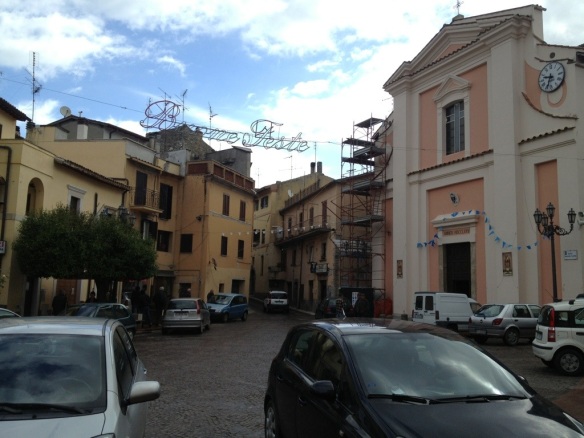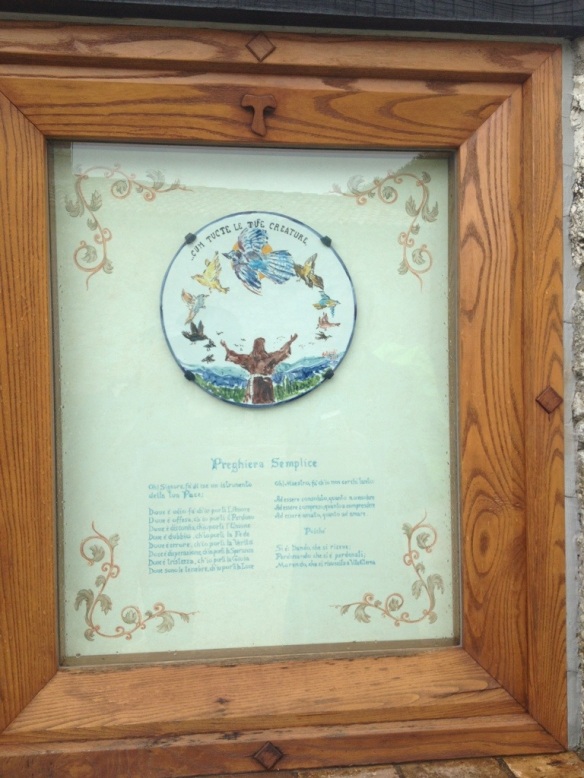We Americans somehow are taught to believe we’re ahead of the rest of the world, but after spending the last two months in Italy, I’m pretty impressed and occasionally a little bothered by how surprisingly civilized this place is. This is true in my temporary residence in Perugia, sister city to Seattle, my home town.
I don’t want to pretend Italy is always clean and proper. A man stopped Theresa and me the other day, and after discovering we are American, went on a long rant about how Italians throw garbage everywhere. Sure enough, in Rome the other day I chose not to take a picture of two men sitting on park benches surrounded by litter. I didn’t want it sullying the Chamber of Commerce style photos I’ll use in my guidebook.
But still, Italians are surprisingly progressive, and Perugia is a good example of this. For instance,
- Every day is a bidet day — As I’ve traveled Italy for the last two months I lived with a family and also stayed in a variety of hotels. Without exception each bathroom came equipped with a bidet or bidet-equipped toilet. These refreshing devices are virtually unknown in America, so a little instruction could be necessary for us Yanks. The goal is cleanliness — even, as we say in America, where the sun don’t shine. That’s progress.
- Garbage is picked up SIX times a week — While progressive Seattle is considering
moving to biweekly garbage pickup, Perugia picks up four types of garbage a total of six times a week. On Monday put your landfill garbage on the doorstep. On Tuesday put out your paper and cardboard. On Wednesday, your compostable. Thursday put out your plastic, glass and metal. Friday it’s compostables again. On Saturday, take a day off to rest because on Sunday — it’s compostable day once more. I was up late and watched the process last night: a worker comes by in a tiny, white dump truck and picks up the bags. No smelly outside garbage cans at all, at least here in the historic center city.
- Don’t touch the fruit — Correct etiquette at Italian supermarkets is to use handy, disposable plastic gloves to pick out your fruits and vegetables. Even at fruit stands you point at what you want and the clerk gets it for you. I thought about the need for cleanliness in American supermarkets last spring. I watched as someone in front of me squeezed a half dozen plums with her bare hands before picking her own. I don’t know that she was carrying any germs of any kind, but how do you disinfect a plum before eating it?
- The streets get swept — Last night two serious-looking men with long, Italian, witch-
style brooms wearing reflective vests walked down the narrow street outside my window and swept little bits of trash into the middle of the road. Right behind them came a mechanical street sweeper that swept and vacuumed up the debris, finishing the cleaning with a gentle rinse. I remember Mayor McGinn of Seattle desperately asking Seattle residents to go out to the corner and pick up fallen leaves because a rainstorm was coming. At least in Perugia, nothing stays around long enough on the street to clog anything.
- My morning coffee costs €1.50 — Yep, all that great, inexpensive Italian coffee has scared away Starbucks. Who would buy a $3.50 latte when a real, Italian cafe latte is the equivalent of about $2.00? Yes, I drink it standing up in a cafe/bar with no WiFi or cushy chairs that doesn’t open until 8:00 a.m., but tastes just as good — maybe better. And I don’t have to tell the barista what my plans are for the day.
- Italians take a nap in the afternoon — Americans think this is incredibly lazy, but the hot afternoons explain why Italians button up their stores at 1:00 and don’t return until 4:30 or 5:00 p.m. They are cool at home, with the shutters and windows closed
on the sunny side of their home or apartment, where the stone walls absorb the heat during the day and radiate it at night. Who’s outside in the heat of the day? As it turns out, it’s the tourists. They sweat their way through the shopping streets, wondering why all the stores are closed. Italian business owners would never think of opening their doors midday for the tourists — forget the business, it’s just too hot.
- You’re not going to read about gun violence — You knew I’d mention this. Yes, Italy’s gun death rate — in spite of all the Mafia talk — is only 1.28 per 100,000. The USA is 9.42. According to my calculator, which I have no reason to disbelieve, we’re 7.4 times more likely to die by a gun in the US than in Italy. Yesterday the wind slammed the door of my bedroom shut, which sounded to me a lot like a gun going off. I worried that my neighbors would wonder if I’d fired a weapon, but then I realized they’re not living in gun culture here. They probably thought it was just a door.

“Enough carrots,” Bugs says. “Prosciutto today!” Sorry, Porky Pig, but Italians are into ham. Big time.
Well, there are some things that seem little uncivilized, too. Like, I’m not sure why cashiers don’t put my change right into my hand rather than into a little dish by the register. And I wish Italy would ban smoking in outdoor restaurants as well as indoors. Also, I wish there were cold, unsweetened drinks available somewhere — anywhere. And I still don’t get how moms, dads, grandparents, teenagers and babies in strollers can stay out each night until after midnight, wandering the streets in nice clothes with gelato cones in hand. At that time of day in America we’re all watching TV.
But this is how it’s done in a traditional and ancient country that sometimes is a little more civilized.







 Our last full day together in Rome –goofing off in front of Trevi Fountain
Our last full day together in Rome –goofing off in front of Trevi Fountain Interior of the Church of St John in the Lateran
Interior of the Church of St John in the Lateran Francis monument opposite Lateran church
Francis monument opposite Lateran church Four pilgrims in front of the Colisseo
Four pilgrims in front of the Colisseo Jacqueline found this, our first waymark of the day
Jacqueline found this, our first waymark of the day Our path followed the river through glades of bamboo
Our path followed the river through glades of bamboo Following the bike paths by Rome’s big parks
Following the bike paths by Rome’s big parks Ah, there it is!
Ah, there it is! Pilgrims arrive at the tomb of St Peter
Pilgrims arrive at the tomb of St Peter This beautiful church was always on my list to see.
This beautiful church was always on my list to see. My pilgrim credential, with today’s stamp, final for this walk, in the lower right
My pilgrim credential, with today’s stamp, final for this walk, in the lower right Way, way off in the distance: St Peter’s Basilica — 30 km away
Way, way off in the distance: St Peter’s Basilica — 30 km away Three pilgrims, nearing Rome
Three pilgrims, nearing Rome Three pilgrims ahead, getting close to Rome
Three pilgrims ahead, getting close to Rome Church of Angelli Custodi, Monte Sacro
Church of Angelli Custodi, Monte Sacro Look for the castle up there on the hill
Look for the castle up there on the hill Our noontime piazza — Montelibretti
Our noontime piazza — Montelibretti Jacqueline and Andreas marching onward, Montelibretti in the distant background
Jacqueline and Andreas marching onward, Montelibretti in the distant background Sebastiano Pelegrino
Sebastiano Pelegrino B&B on the left, typical street of Monte Rotondo straight ahead
B&B on the left, typical street of Monte Rotondo straight ahead Scene of our Sunday mass — The Duomo of Monterotondo
Scene of our Sunday mass — The Duomo of Monterotondo We set out from Poggio San Lorenzo under partly cloudy skies
We set out from Poggio San Lorenzo under partly cloudy skies Piazza at Montelione en Sabina
Piazza at Montelione en Sabina Walking through vineyards
Walking through vineyards Views through sporadic rain as we approached Ponticelli among olive orchards
Views through sporadic rain as we approached Ponticelli among olive orchards View from one of the “ups” in literally an up and down day
View from one of the “ups” in literally an up and down day Serendipity in the piazza
Serendipity in the piazza Just 100 kilometers left until Rome
Just 100 kilometers left until Rome Trail beside the burbling creek
Trail beside the burbling creek My view much of the day, this time on a steep uphill
My view much of the day, this time on a steep uphill Pilgrims’ self portrait
Pilgrims’ self portrait From left: Sebastian, Andreas, Jacqueline, our host, Feliciano, me
From left: Sebastian, Andreas, Jacqueline, our host, Feliciano, me Our group, this time in the yoga room with Michelle
Our group, this time in the yoga room with Michelle Cantalice rising above us
Cantalice rising above us Church of San Felize, in honor of Cantalice’s homegrown saint
Church of San Felize, in honor of Cantalice’s homegrown saint Views back to Poggio Bustone, today’s starting point, nestled on the mountainside in the distance
Views back to Poggio Bustone, today’s starting point, nestled on the mountainside in the distance Looking toward the tower of Reiti’s cathedral
Looking toward the tower of Reiti’s cathedral The panoramic view from our room as we awoke, window closed
The panoramic view from our room as we awoke, window closed The panoramic view an hour later, window open
The panoramic view an hour later, window open From left: Andreas, Sebastian, Jacqueline, me
From left: Andreas, Sebastian, Jacqueline, me A plaque at the top of yesterday’s climb — the prayer of St Francis, “Lord, make me an instrument of your peace…”
A plaque at the top of yesterday’s climb — the prayer of St Francis, “Lord, make me an instrument of your peace…”